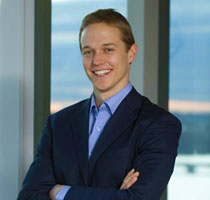
Geoffrey von Maltzahn PhD ’10, Flagship Ventures VentureLabs Partner
The Making of a Serial Inventor-Entrepreneur
Geoffrey von Maltzahn PhD ’10, Flagship Ventures VentureLabs Partner
In November 2014, Flagship Ventures announced Geoffrey von Maltzahn’s third company since joining the firm, his seventh, if you include the four he co-founded as a graduate student in HST’s Medical Engineering and Medical Physics (MEMP) PhD program. The company, Symbiota, aims to tackle a completely new space for von Maltzahn: agriculture.
Symbiota takes an industry that has focused for as long as anyone can remember on plant biology and the chemistry of the environments crops are grown in, and adds a third novel consideration — the plant’s microbiome— to improve plant health, resilience and yield. This approach of taking modern scientific advances, such as tools to understand and improve the microbes in and around organisms, and applying them where they are needed most is emblematic of von Maltzahn’s work. “I’m putting my time toward forming companies that can create a new industry or fundamentally change a problem space,” he says. “Which means I don’t sleep much.”
After completing an undergraduate degree in chemical engineering at MIT and a Master’s in bioengineering at the University of California, San Diego, he went looking for a graduate program with an interdisciplinary approach to the study of biology that maintained the rigor of engineering. He found it in the HST program. “MEMP offers a medical curriculum for PhD students that is identical to the curriculum for medical students, yet without alleviating the expectations of excellence in scientific and engineering disciplines,” he says. “You have to master both.”
He joined the laboratory of Sangeeta Bhatia, a faculty member in Electrical Engineering and Computer Science and the Institute of Medical Engineering and Science (IMES) at MIT, who runs a multi-disciplinary group not just focused on advancing science, but also on making a difference in medicine. There he developed a range of innovations, including several new nanomedicine tools to enhance diagnostics, imaging and drug delivery. He also won several awards for his inventions, including the Lemelson-MIT Student Prize for tumor-homing nanoparticles and ‘communicating therapeutics’ that work together to treat diseases.
For von Maltzahn, his exposure to entrepreneurship at HST was career shaping. “Inventing companies is sort of a hyper-disciplinary thing,” he says. “I need to think deeply about science and invention, but also about regulation and intellectual property and markets to have impact.”
Von Maltzahn launched several successful startups during his time at HST, including Sienna Labs, which he formed with two other HST students and now serves on the board of scientific advisors. The company is creating the new category of ‘plasmonic therapeutics’ that harness the power of laser medicine for skin disorders formerly only treatable using drugs.
As he concluded doctoral studies, von Maltzahn planned to form his own academic lab. He envisioned a lab not unlike Bhatia’s, with a strong focus on multidisciplinary research and innovation, but with an added layer of business acumen fitting for budding entrepreneurs. But a meeting with the founder and CEO of Flagship Ventures, Noubar Afeyan, opened a new path. Afeyan described Flagship’s Ventures’ track record for systematically creating startups that originate innovations based on cutting-edge scientific, engineering and business insights.
The opportunity matched von Maltzahn’s ambition, adding great resources, venture-driven colleagues, tremendous entrepreneurial experience, and the hyper-disciplinary rigor von Maltzahn thrives on. He has since been living the life of a professional inventor and entrepreneur. He spends his time identifying big challenges, sometimes in industries he’s never worked in before, learning everything he can about them, trying to invent a new solution, and then building a startup to make a dent in the problem. “We work to prove the technology’s potential,” he says. “Then I transition into a new space.”